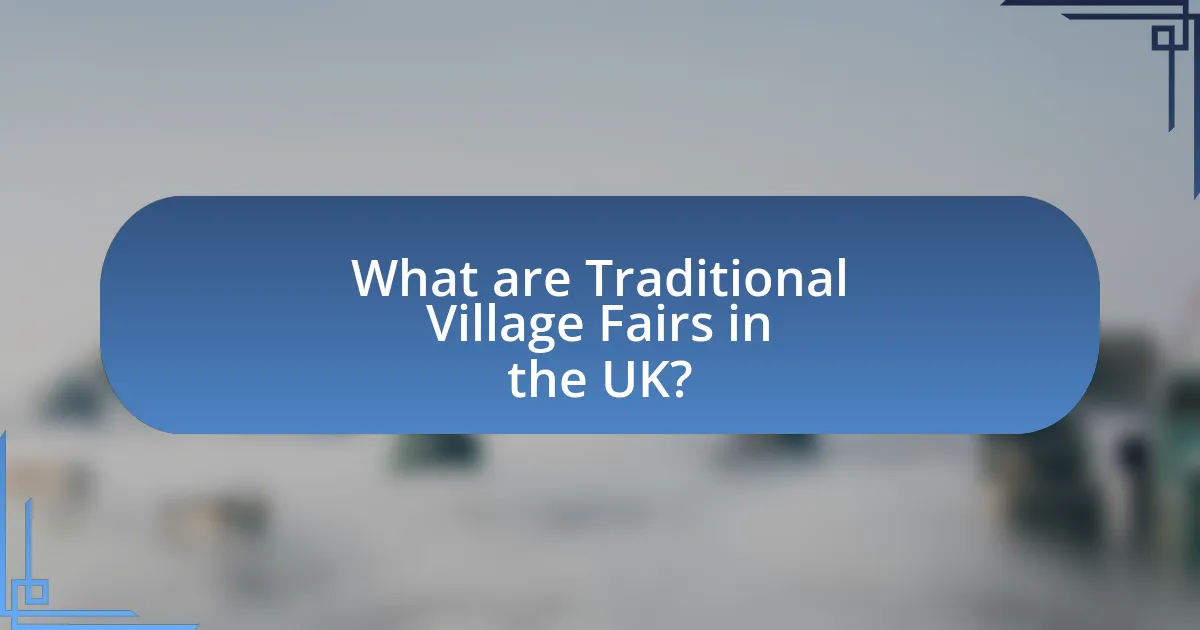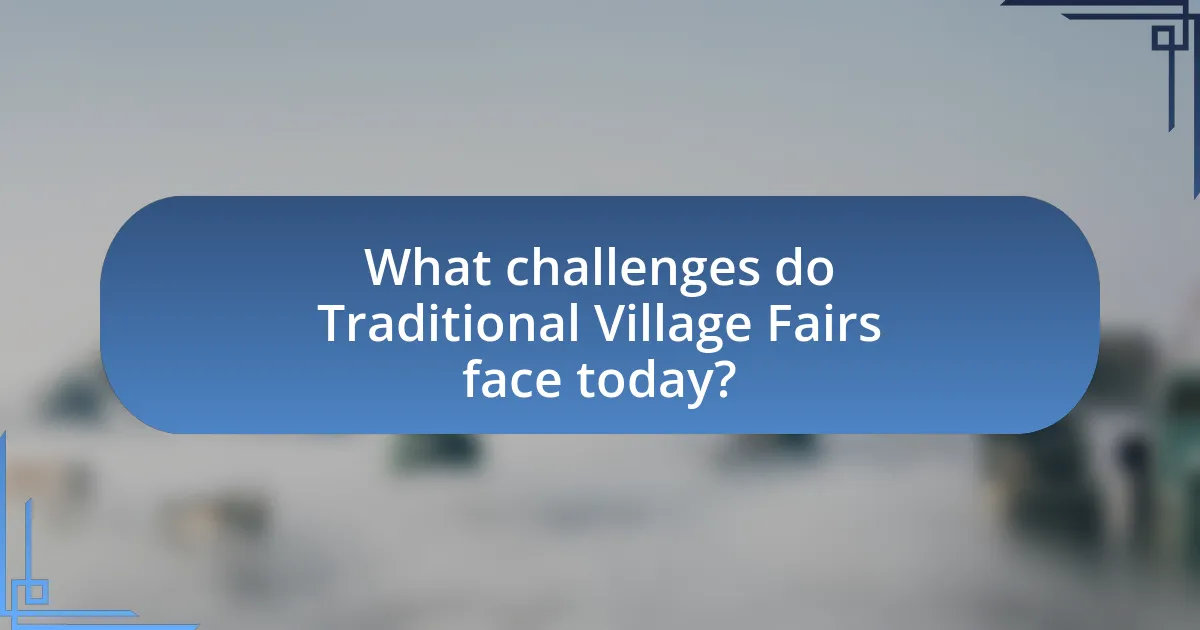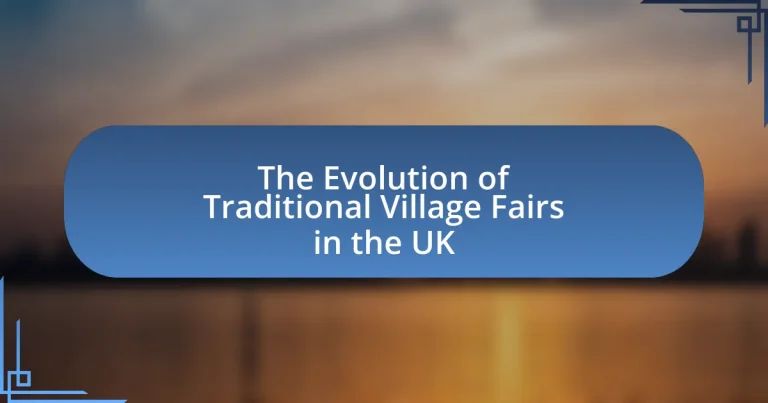Traditional Village Fairs in the UK are community events with historical roots that celebrate local culture, agriculture, and crafts. These fairs have evolved from medieval marketplaces into multifaceted gatherings featuring entertainment, competitions, and local food, reflecting the unique traditions of each village. The article explores the historical influences on these fairs, their cultural significance, and the challenges they face today, including declining attendance and modernization. It also discusses strategies for revitalization, the role of technology, and best practices for organizing successful events, highlighting the importance of community engagement and local heritage in sustaining these traditional celebrations.

What are Traditional Village Fairs in the UK?
Traditional Village Fairs in the UK are community events that celebrate local culture, agriculture, and crafts, often featuring stalls, games, and entertainment. These fairs have historical roots dating back to medieval times, originally serving as marketplaces for local farmers and artisans to sell their goods. Over the centuries, they have evolved to include various activities such as music performances, competitions, and food stalls, reflecting the unique traditions of each village. The significance of these fairs is underscored by their role in fostering community spirit and preserving local heritage, with many villages hosting annual events that attract visitors and promote local economies.
How have Traditional Village Fairs evolved over time?
Traditional village fairs in the UK have evolved from simple agricultural gatherings into multifaceted community events that incorporate entertainment, commerce, and cultural activities. Initially, these fairs served as marketplaces for farmers to sell their produce and livestock, often coinciding with harvest seasons, as evidenced by historical records from the Middle Ages. Over time, the introduction of various attractions such as games, music, and food stalls transformed these fairs into social hubs, reflecting changes in societal interests and economic conditions. By the 19th century, the rise of industrialization and urbanization further diversified the offerings at village fairs, leading to the inclusion of traveling circuses and exhibitions. Today, traditional village fairs often celebrate local heritage and arts, showcasing crafts and performances, while still retaining elements of their agricultural roots, demonstrating their adaptability to contemporary cultural trends.
What historical events influenced the development of these fairs?
The development of traditional village fairs in the UK was significantly influenced by the establishment of market charters in the medieval period. These charters, granted by monarchs, allowed towns to hold regular markets and fairs, fostering local trade and community gatherings. For instance, the 1215 Magna Carta included provisions that protected the rights of towns to hold fairs, which led to the proliferation of such events across England. Additionally, the agricultural revolution in the 18th century increased food production, resulting in larger gatherings where farmers could sell their surplus, further embedding fairs into the social fabric of rural life.
How did agricultural practices shape the nature of village fairs?
Agricultural practices significantly shaped the nature of village fairs by determining the types of goods and activities featured at these events. Historically, village fairs emerged as a platform for farmers to showcase and sell their produce, such as crops and livestock, which were directly influenced by seasonal agricultural cycles. For instance, fairs often coincided with harvest times, allowing farmers to display their best yields and engage in trade, thus fostering community interaction and economic exchange. Additionally, the introduction of specific agricultural techniques, such as crop rotation and selective breeding, led to a diversification of products available at fairs, enhancing their appeal and cultural significance within rural communities.
What cultural significance do Traditional Village Fairs hold?
Traditional Village Fairs hold significant cultural importance as they serve as a platform for community bonding, cultural expression, and the preservation of local traditions. These fairs often feature traditional crafts, local foods, and performances that reflect the unique heritage of the area, fostering a sense of identity among residents. Historically, village fairs have been a means of social interaction, allowing people to gather, celebrate, and strengthen community ties, which is evidenced by their long-standing presence in British culture since medieval times. The continuity of these events highlights their role in maintaining cultural practices and promoting local economies, as they attract visitors and encourage the sale of local goods.
How do these fairs reflect local traditions and community values?
Traditional village fairs in the UK reflect local traditions and community values by showcasing regional customs, crafts, and agricultural practices. These fairs often feature local foods, handmade goods, and performances that highlight the unique cultural heritage of the area, reinforcing community identity. For instance, events like the Appleby Horse Fair celebrate historical practices and foster social cohesion among residents. Additionally, the inclusion of local charities and community groups in these fairs emphasizes collective values and support for one another, further embedding the significance of community in these gatherings.
What role do village fairs play in fostering community spirit?
Village fairs play a crucial role in fostering community spirit by providing a platform for social interaction and cultural exchange among residents. These events encourage participation from diverse groups within the village, promoting a sense of belonging and unity. Historically, village fairs have served as communal gatherings where local traditions, crafts, and food are showcased, reinforcing cultural identity and shared values. For instance, studies have shown that such fairs can increase community engagement and strengthen social ties, as they often involve collaborative planning and execution by local organizations and volunteers. This collective effort not only enhances relationships among villagers but also instills pride in the community, making village fairs essential for nurturing a vibrant community spirit.

What are the key features of Traditional Village Fairs?
Traditional village fairs are characterized by community engagement, local crafts, food stalls, entertainment, and cultural activities. These fairs serve as a platform for local artisans to showcase handmade goods, fostering economic support within the community. Food stalls typically feature traditional dishes, promoting local cuisine and agricultural products. Entertainment often includes music, dance performances, and games, enhancing social interaction among attendees. Additionally, cultural activities may involve storytelling, traditional sports, and exhibitions that reflect the village’s heritage, thereby preserving local customs and traditions.
What types of activities are typically found at these fairs?
Traditional village fairs in the UK typically feature a variety of activities including craft stalls, food vendors, live music performances, games, and competitions. These fairs often showcase local artisans and producers, allowing attendees to purchase handmade goods and regional delicacies. Additionally, entertainment such as traditional dances, puppet shows, and children’s activities are common, fostering community engagement and cultural heritage. Historical records indicate that these fairs have evolved from medieval markets into vibrant community events, reflecting local customs and traditions.
How do games and competitions enhance the fair experience?
Games and competitions enhance the fair experience by fostering community engagement and promoting social interaction among participants. These activities create an atmosphere of excitement and friendly rivalry, encouraging attendees to connect with one another. Historical evidence shows that traditional village fairs in the UK have included games like tug-of-war and sack races, which not only entertain but also strengthen local bonds. Furthermore, competitions often involve prizes, motivating participation and enhancing the overall enjoyment of the fair, as seen in events where local artisans showcase their skills through contests.
What types of food and crafts are commonly showcased?
Traditional village fairs in the UK commonly showcase local foods such as artisanal cheeses, homemade jams, and baked goods, alongside crafts like handmade pottery, textiles, and woodwork. These food items often reflect regional specialties, with many fairs featuring products sourced from local farms and producers, emphasizing the importance of community and local economy. Crafts displayed at these fairs typically highlight traditional skills and craftsmanship, often passed down through generations, which adds cultural significance to the events.
How do Traditional Village Fairs vary across different regions of the UK?
Traditional village fairs in the UK vary significantly by region, reflecting local customs, agricultural practices, and cultural heritage. For instance, in the West Midlands, fairs often feature livestock shows and agricultural competitions, highlighting the area’s farming traditions. In contrast, coastal regions like Cornwall host fairs that emphasize maritime themes, including fishing contests and seafood stalls, showcasing their connection to the sea. Additionally, fairs in Scotland may incorporate Highland games, emphasizing traditional Scottish sports and music, while fairs in the North of England often include historical reenactments, celebrating local history. These regional differences illustrate how traditional village fairs serve as a reflection of the unique cultural identities and economic activities of their respective areas.
What unique traditions are associated with village fairs in Scotland?
Unique traditions associated with village fairs in Scotland include the celebration of local culture through events such as Highland games, where traditional sports like caber tossing and tug-of-war take place. Additionally, village fairs often feature displays of local crafts, food stalls offering regional delicacies, and music performances that highlight Scottish folk traditions. These fairs serve as a gathering point for communities, reinforcing social bonds and preserving cultural heritage, as evidenced by their historical roots dating back to the medieval period when they were originally established for trade and celebration.
How do village fairs in England differ from those in Wales and Northern Ireland?
Village fairs in England typically emphasize agricultural displays and local produce, reflecting the region’s strong farming heritage, while those in Wales often incorporate traditional music and cultural performances, showcasing the Welsh language and heritage. In Northern Ireland, village fairs frequently focus on community events and family-oriented activities, influenced by local customs and historical events. These differences highlight the unique cultural identities and traditions of each region, with England’s fairs leaning towards agricultural themes, Wales celebrating cultural heritage, and Northern Ireland fostering community engagement.

What challenges do Traditional Village Fairs face today?
Traditional village fairs in the UK face several challenges today, including declining attendance, competition from modern entertainment options, and the impact of economic factors. Declining attendance is often attributed to changing social dynamics and urbanization, which have led to fewer people participating in local events. Competition from modern entertainment, such as digital media and large-scale festivals, diverts potential visitors away from traditional fairs. Economic factors, including budget constraints for organizing committees and rising costs for vendors, further complicate the sustainability of these events. According to a report by the National Association of Local Councils, many village fairs have seen a 30% drop in attendance over the past decade, highlighting the urgency of addressing these challenges.
How has modernization impacted the attendance and organization of these fairs?
Modernization has significantly increased attendance and transformed the organization of traditional village fairs in the UK. The integration of digital marketing strategies, such as social media promotion and online ticket sales, has broadened the reach of these events, attracting a more diverse audience. For instance, the use of platforms like Facebook and Instagram allows organizers to engage with potential attendees in real-time, resulting in higher turnout rates compared to traditional methods. Additionally, the incorporation of modern amenities, such as cashless payment systems and mobile apps for event navigation, has streamlined the overall experience for visitors, making fairs more accessible and enjoyable. This shift towards modernization has not only enhanced participation but also improved logistical planning, allowing for better resource management and a more organized event structure.
What are the financial challenges faced by fair organizers?
Fair organizers face several financial challenges, including high operational costs, fluctuating attendance, and reliance on sponsorships. Operational costs encompass venue rental, permits, insurance, and staffing, which can significantly impact budgets. Fluctuating attendance affects revenue from ticket sales and vendor fees, making financial forecasting difficult. Additionally, many fairs depend on sponsorships, which can be inconsistent and influenced by economic conditions, further complicating financial stability. According to a study by the UK’s National Farmers’ Union, 60% of rural events reported financial difficulties due to these factors, highlighting the pressing nature of these challenges.
How do changing demographics affect participation in village fairs?
Changing demographics significantly influence participation in village fairs by altering the cultural interests and availability of potential attendees. For instance, as populations become more urbanized and younger generations move to cities, traditional village fairs may see a decline in local participation. According to the Office for National Statistics, rural areas in the UK have experienced a population decrease of 0.5% annually since 2011, leading to fewer residents available to attend these events. Additionally, demographic shifts towards more diverse communities can result in varying interests that may not align with traditional fair activities, potentially reducing engagement.
What strategies can be employed to revitalize Traditional Village Fairs?
To revitalize Traditional Village Fairs, communities can implement strategies such as enhancing marketing efforts, diversifying activities, and fostering local partnerships. Enhanced marketing can attract a broader audience by utilizing social media and local advertising to promote the fair’s unique offerings. Diversifying activities, such as incorporating workshops, live performances, and food tastings, can engage different demographics and encourage repeat attendance. Fostering partnerships with local businesses and artisans can create a sense of community ownership and support, leading to increased participation and investment in the fair. These strategies are supported by case studies showing that fairs with diverse programming and strong community ties experience higher attendance and satisfaction rates.
How can technology be leveraged to enhance the fair experience?
Technology can be leveraged to enhance the fair experience by integrating mobile applications that provide real-time information about events, schedules, and vendor locations. These applications can improve visitor engagement by offering interactive maps, notifications for upcoming activities, and digital ticketing options, which streamline entry and reduce wait times. For instance, a study by the UK’s Department for Digital, Culture, Media and Sport found that events utilizing mobile technology saw a 30% increase in attendee satisfaction due to improved access to information and services. Additionally, social media platforms can be used to promote fairs, share live updates, and gather feedback, further enriching the overall experience for attendees.
What role can local governments play in supporting village fairs?
Local governments can play a crucial role in supporting village fairs by providing funding, resources, and logistical assistance. They can allocate budgets specifically for community events, ensuring that village fairs have the financial backing necessary for organization and promotion. Additionally, local governments can facilitate permits and licenses, making it easier for organizers to host these events. For instance, in the UK, many councils have established community grants aimed at enhancing local cultural activities, which directly benefits village fairs. This support not only fosters community engagement but also stimulates local economies by attracting visitors and vendors.
What are some best practices for organizing a successful Traditional Village Fair?
To organize a successful Traditional Village Fair, it is essential to engage the community, plan logistics meticulously, and promote the event effectively. Engaging the community involves involving local residents in the planning process, ensuring that the fair reflects their interests and traditions. Meticulous planning includes selecting an appropriate venue, scheduling activities, and coordinating vendors, which can enhance the overall experience. Effective promotion through social media, local newspapers, and community boards can increase attendance and awareness. Historical data shows that well-organized fairs can attract hundreds to thousands of visitors, significantly benefiting local economies and fostering community spirit.


